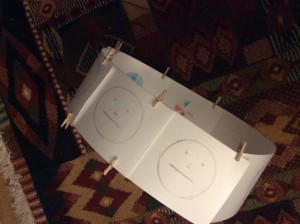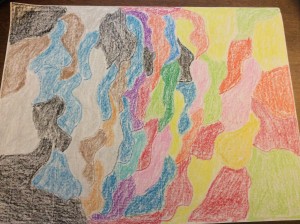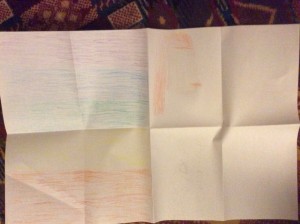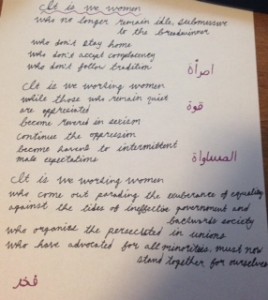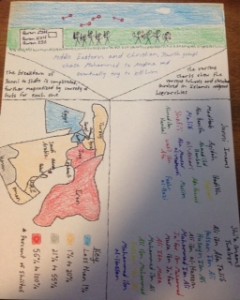Introductory Essay
ø
Mikeal Parsons
Freshman Seminar Response Paper
I remember my excitement when I was placed into a freshman seminar on the German philosopher Friedrich Nietzsche. I had a strong background in German philosophy and a personal admiration of Nietzsche. I arrived in class the first day and was one of 12 white males in the seminar taught by a young Caucasian professor. I enjoyed the first discussion but also wondered if I was making the most of the diversity that should be explored in a setting so intimate as that of the Harvard Freshman Seminar. However I was soon to undergo a dramatic change in setting and topic when I discovered a conflict in my schedule that would prevent me from continuing my participation in the Nietzsche seminar. In every way possible, I would be placed into a very different setting studying a very different subject than that of my previous seminar or anything available to me in Waco Texas.
Upon arriving I was greeted by a unique group of students and teacher that provide me with my first “this is Harvard” moment. Since then I have only been captivated by each person’s attributes, background and resulting insights. I really feel as if spending two hours a week with any single person in the class could have provided me with an ability for personal reflection and transformation so being surrounded by all 11 and the professor would truly become overwhelming at times. I typically try to read everyone’s response before coming to class and in doing so have been much more successful in contextualizing each person’s comments throughout the discussion within the framework of their written words. Because I will address the readings later in the paper, I can say I think the conversations derived from the readings were some of the more entertaining and informative discussions I have been a part of. People shared everything from personal philosophies to opinions on foreign policy both inside and outside of the middle-east. The strong opinions of each person however, were never hampered by an environment not open to any and all ideas. Disagreements occurred but they were discussed with mutual inclusivity and with the other persons view point always at the forefront of their argument.
I was very intimidated the first class I attended because of my lack of prior Islamic understanding, culturally or religiously. But very quickly I discovered this made me the perfect candidate for the class. Growing up in a family with two parents as professors, and professors of the culturally rich subjects of biblical theology and renaissance art history, I had developed a way of thinking that made me more receptive of unfamiliar societies than the average person. When I discovered the best way to attain the knowledge of my peers and professor, I also discovered the best way for me to enhance the learning experience of those around me. The way I could do this was not pretending to be an expert of any part of the culture as many of the students in the class were, but instead relate what I learned in an analogous comparison with that which I did understand. This served too purposes. The first was to provide other students in the class with an alternative way of understanding the complexities of Islamic culture that helped simplify some of the major themes. The second, less apparent way, was for those who did have a firm grasp on the intricacies of an Islamic characteristic as they could now hear a different viewpoint and relate what they understood to a potentially new concept they may not have as much experience with. All in all the class developed not only my understanding of Islam but also my ability to learn from and teach to those around me.
The second aspect of the class I want to reflect on is that of the literature. Because I will explore the analytics and rhetorical implications of several pieces I will focus primarily on the impacts, applicability and understandings I found in the literature. The first reading of “Following Muhammad: Rethinking Islam in the Contemporary World” remained the most powerful reading for me throughout the seminar as it provided a necessary debunking of classic western misconceptions. In fact what really resonated was the mention of Waco alongside Syria and Afghanistan. Of course being from Waco I am more than aware of the tragic events that transpired at the hand of a few crazed religious fundamentalists however I never considered it central to the identity of Waco and certainly not to the identity of our nation. And prior to this class I believe it was a result of Waco being subjected to this one isolated incident and I would chalk it up to a blip in the history of Waco. However that is not how it is regarded by outsiders, as I would understand over the span of my life. Any time I was not in Waco and would mention where I was from, those who had heard of it had heard of it only for the Branch Davidians and their isolated actions. I thought hard about this, and while there have been more than just a few isolated religious fanatical events in Syria and Afghanistan, the author chose to equate the three for a reason. And this reason I believe is to show how the majority of people in those regions are marginalized by a radical minority. It is a very rare occurrence for such an event to transpire, but it can continue not because of the oppression that comes from the religious fanatics, but from the neglect of other societies around the world as a result of their acceptance of the misconception that there is nothing of note in Syria besides the political unrest as a result of religious fanatics, that there is nothing of note in Afghanistan besides American apathy as a result of religious fanatics, that there is nothing in Waco besides backward thinking fundamentalists as a result of religious fanatics. There is a clear theme here, and religious literacy and cultural empathy is necessary in transcending the view that has now become the status quo.
And finally, when contemplating what I will retain five years from now and further down the road I am prompted to answer with lessons learned about how to approach such religious discussions. It is not necessarily specific facts about Islam or authors but instead it is the overall message of Islam which at its root is a religion, not a political manifesto. This will absolutely remain at the forefront of my consciousness but there are multiple aspects I hope to continue to reflect upon and expand my knowledge of. In particular I have been fascinated by Islamic art work and its incorporation of the written word into the art. I have always grown up to appreciate art in a form of representing people and situations. I have enjoyed modern art but never truly seen the significance of it and have always been partial to older works. But experiencing art in the Islamic culture has changed my perspective on things. When I fully realized the extent to which the written and spoken word are valued and then saw it illustrated in art I was moved in a way very different from other art forms. It seemed to do a wonderful job of embodying multiple aspects of the country. It gives a creative sense to the piece through illustration but then draws upon the uniformity and familiarity of words. If I can retain these two things, the message of Islam and the novelty of its art work, I will have regarded his class as a great success.
In conclusion I have greatly enjoyed learning from each person and truly believe I have gained lessons that will last me for a very long time. It has provided me with an ability to reflect on other cultures despite opposition found in the media. The best way to understand a culture at its present time is by reading popular, and rejected literature by people of the society. This was our approach for the last 12 weeks and I feel much more enlightened because of it. Being a freshman I was very pleased with the type of transformation I have been provided with in only my first semester. It was a nice supplement to my predominantly STEM schedule. I hope to take classes on various cultures in the future and look forward to the possibility of expanding my understanding of Islam in coming semesters.

